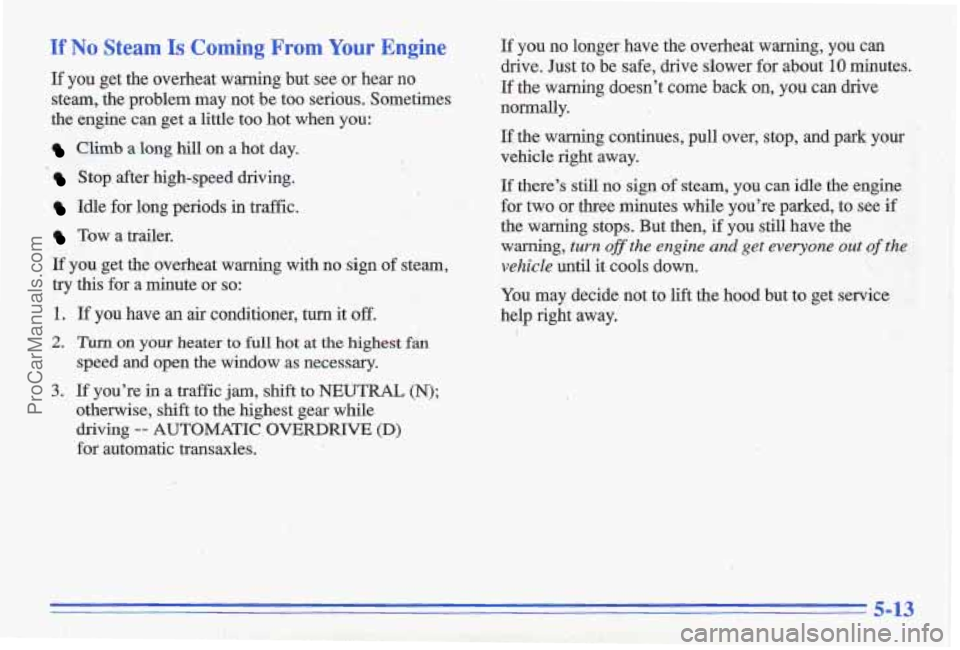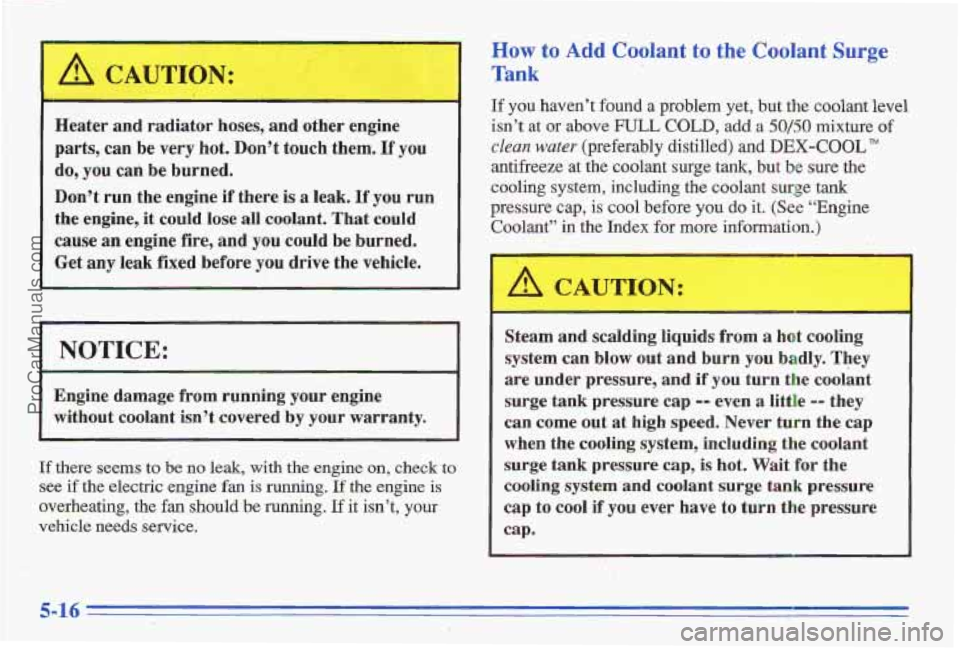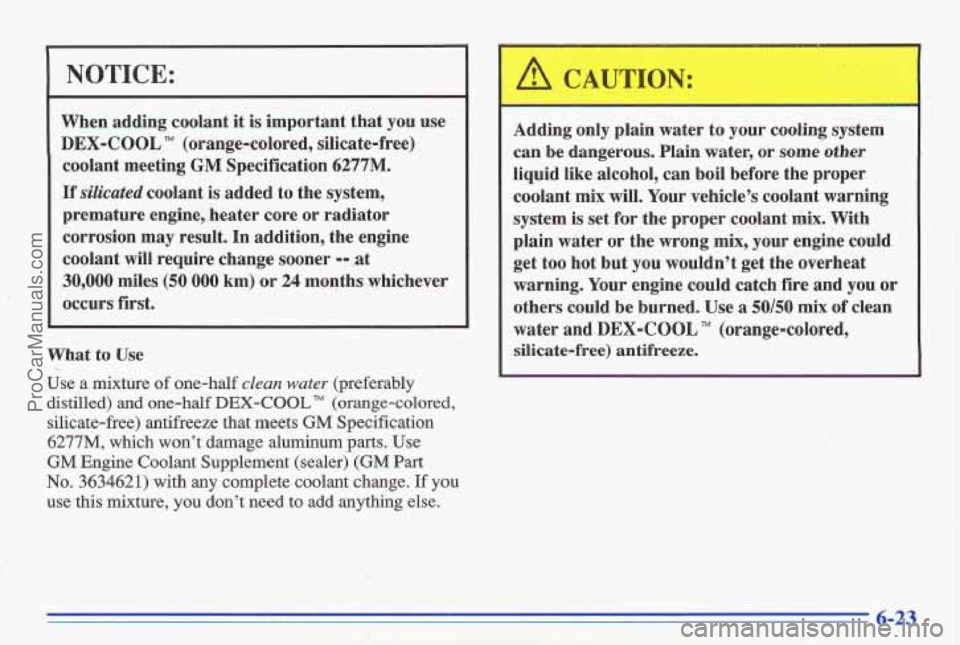Page 203 of 356

If No Steam Is Coming From Your Engine
If you get the overheat warning but see or hear no
steam, the problem may not b'e too serious. Sometimes
the engine can get a little too hot when you:
Cbb a long hill on a hot day.
' Stop after high-speed driving.
Idle for long periods in traffic.
Tow a trailer.
If you get the overheat warning with no sign of steam,
try this for a minute or so:
1. If you have an air conditioner, turn it off.
2. Turn on your heater to full hot at the highest fan
speed and open the window as necessary.
3. If you're in a traffic jam, shift to NEUTRAL (N);
otherwise, shift to the highest gear while
driving
-- AUTOMATIC OVERDRIVE (D)
for automatic transaxles. ;+, 1; , !, -.,.r., . .-I? ,*:, I,3 : 1 I' ' . . :4?,+ . .I .
If you no longer have the overheat warning, you can
drive. Just to be safe, drive slower for about 10 minutes.
If the warning doesn't come back on, you can drive
normally.
If the warning continues, pull over, stop, and park your
vehicle right away.
If there's still no sign of steam, you can idle the engine
for two or three minutes while you're parked, to see
if
the warning stops. But then, if you still have the
warning,
turn ojf the engine and get everyone out of the
vehicle
until it cools down.
You may decide not .to lift the hood but to get service
help right 'away.
5-13
ProCarManuals.com
Page 205 of 356
' A CAUTION:
An electric fan under the hood can start up even
when the engine is not running and can injure
you. Keep hands, clothing and tools away from
any underhood electric
fan.
1
If tkie coolant inside the coolant surge tank is boiling,
don't
do anything else until it cools down.
The coolant level should be at or above FULL COLD. If
it isn't, you my have a leak in the radiator hoses, heater
hoses, radiator, water pump
or somewhere else in the
cooling system.
"I '!
_.
-. .
, :.' I' I1
ProCarManuals.com
Page 206 of 356

6!!l CAUTION:
~~~ ~
Heater and radiator hoses, and other engine
parts, can be very hot. Don’t touch them.
If you
do, you can be. burned.
Donst run the engine
if there is a leak. If you run
the engine, it could
lose all coolant. That coulld
cause an engine
fire, and you could be burned.
Get
any leak fixed before you drive the vehicle.
without coolant isn’t covered
by your warranty.
If there seems to be no leak, with the engine on, check to
see if the electric engine fan is running. If the engine is
overheating, the fan should be running. If it isn’t, your
vehicle needs service.
How to Add Coolant to the Coolant Surge
Tank
If you haven’t found a problem yet, but the coolant level
isn’t at
or above FULL COLD, add a 50150 mixture of
clean water (preferably distilled) and DEX-COOL
antifreeze at the coolant surge tank, but be sure the
cooling
system, including the coolant surge tank
pressure cap,
is COO^ before you do it, (See “Engine
Coolant” in the Index for more infomati .) - --
I
Steam and scalding liquids from a hot cooling
system can blow out and burn you badly. They
are under pressure, and
if you turn the coolant
surge tank pressure cap
-- even a little -- they
can come out at high speed. Never turn the cap
when the cooling
system, including the coolant
surge tank pressure
cap, is hot. Wait for the
cooling system and coolant
surge tank pressure.
cap to cool if you ever have to turn the pressure
cap.
5-16
ProCarManuals.com
Page 208 of 356
NOTICE:
In cold weather,-water can freeze and crack the
engine, radiator, heater core and
other parts. So
use the recommended coolant.
You can
be burned if you spill coolant on hot
engine p,arts. Coolant contains ethylene glycol
and
it will burn if the engine parts are .hot I)
enough. Don’t spill coolant on a hot engine.
I
If you hear a hiss, wait for that to stop. A hiss means
there is still some pressure left.
I
5-18
~ -.
ProCarManuals.com
Page 245 of 356

NOTICE:
When adding coolant it is important that you use
DEX-COOL TM (orange-colored, silicate-free)
coolant meeting
GM Specification 6277M.
If silicated coolant is added to the system,
premature engine, heater core or radiator
corrosion may result. In addition, the engine
coolant will require change sooner --,at
30,000 miles
(50 000 km)'or 24 months whichever
occurs first.
What to Use
Use a mixture of one-half clean water (preferably
distilled) and one-half
DEX-COOL TM (orange-colored,
silicate-free) antifreeze that meets GM Specification
6277M, which won't damage aluminum parts. Use
GM Engine Coolant Supplement (sealer) (GM Part
No. 3634621) with any complete coolant change. If you
use this mixture, you don't need to add anything else.
.
Adding only plain water to your cooling system
can be dangerous. Plain water,
or some other
liquid like alcohol, can bo'il before the proper
coolant mix will. Your vehicle's coolant warning'
system is set for the proper coolant mix. With
plain water or the wrong mix, your engine could
get too hot but you wouldn't get the overheat
warning. Your engine could catch
fire and you or
others could be burned. Use a 5060 mix of clean
water and
DEX-COOL (orange-colored,
silicate-free) antifreeze.
f' . ..
ProCarManuals.com
Page 246 of 356
NOTICE:
If you use an improper coolant mix, your engine
could overheat and be badly damaged. The
repair cost wouldn’t be covered by your
warranty. Too much water
in the mix can freeze
and crack the engine, radiator, heater core and
other parts.
If you have to add cooldnt more than four times a year,
have
your dealer check your cooling system,
I NOTICE:
If you use the proper coolant, you don’t have to
add extra inhibitors or additives which claim to
improve the system. These can be harmful.
Checking Coolant
The coolant surge tank is located on the passenger side
of the engine compartment.
0
ProCarManuals.com
Page 278 of 356
Fuse
INT LPS
PWR
ST
RDO IGN
HTR-A/C
CRUISE
TAIL LPS
a Fuse Useage
PWR WDO Power Window (Circuit Breaker)
TURN Turn Signal Lamps
Useage
Alarm Module (Illuminated Entry,
Warning Chimes, Overhead
Lamps., MapJReading Lamps,
Glove Box Lamp, Trunk Lamp,
Radio, Power Mirrors), Anti-Lock
Brakes, Variable
Effort Steering,
Remote Keyless
Entry
Power Seat ?,,,. :. . . .- . - . .. .. Radi&-<-'&'.: ?.>I' ?;~-,~:-~~~,(l ,;,* , ' _. . . I' . &-:.*& . : ' . . I 8.. .~ . . .I d&
Heater/Air Conditioning Blower,
Daytime Running Lamps, Automatic Light Control
Cruise Control
Parking Lamps, Taillamps,
Sidemarker Lamps, License
Lamps, Instrument Panel Lights,
Headlamp
Warning Alarm
Cigarette Lighter
6-56
ProCarManuals.com
Page 280 of 356
Engine Compartment Fuse Block Fuse
F/P INJ
ERLS
ABs/Evo
IGN MOD
HVAC
BLO MOT
PCM BATT
CLG FAN
HDLP
STOP LPS
PWR ACC
RR DEFG
ABS
Usage
Fuel Pump: Fuel Injectors
Back-up
Lamps: Canister Purge Valve,
EGR: Automatic Transmission,
Brake Transmission Shift Interlock,
Anti-lock Brakes: Variable
Effort
Steering, Air Conditioning
Compressor,
Park Lock Solenoid
Anti-Lock Brake Solenoids,
Variable Effort Steering
Ignition System
Heater/Ais Conditioner-High Blower, Generator-Voltage Sense
Powertrain Computer
Engine Cooling Fan
Lighting Circuits
Power Accessories,
Stop Lamp Circuits,
Rear Window Defogger
Anti-Lock Brakes,
Variable
Effort Steering
Ignition Switched Circuits
I , ^*^ >, .. ,.",
The engine compartment fuse block is located on the
driver's side
of the engine compartment, near the battery,
€GN sw
ProCarManuals.com